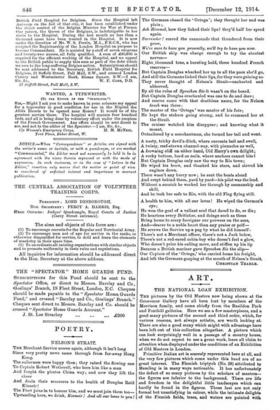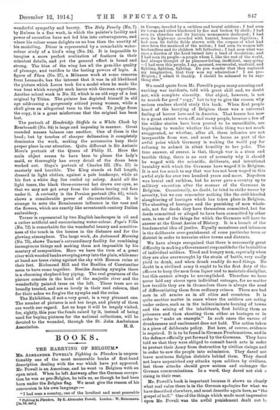ART
•
THE NATIONAL LOAN EXHIBITION.
THE pictures by the Old Masters now being shown at the Grosvenor Gallery have all been lent' by members of the Morrison family, and come chiefly from the Basildon Park and Fonthill galleries. Here we see a few masterpieces, and a good many pictures of the second and third order, which, for various reasons, not always artistic, are worth looking at. There are also a good many which might with advantage have been left out of this collection altogether. A picture which can look surprisingly well in a passage of a country house, when we do not expect to see a great work, loses all claim to attention when displayed under the conditions of an Exhibition of Old Masters in London.
Primitive Italian art is scarcely represented here at all, and the very few pictures which come under this bead are of no great interest. The Flemish triptych (No. 29) attributed to Memling is in many ways noticeable. It has unfortunately the defect of so many pictures by the scholars of masters— the figures are inferior to the background. There are life and freedom in the delightful little landscapes which can hardly be found in the figures. These last are not only formal but unsatisfying in colour, while the intimate delights of the Flemish fields, trees, and waters are painted with wonderful sympathy and beauty. The Holy Family (No, 7) by Rubens is a fine work, in which the painter's facility and power of execution have not led him into extravagances, and where his colour sense delights us no less than the suavity of ' his modelling. Diirer is represented by a remarkable water- colour study of a bird's wing (No. 24). It is impossible to imagine a more perfect realization of feathers in their minutest details, and yet the general effect is broad and strong. The blue of the wing has all the gem-like quality of plumage, and testifies to the lasting powers of lapis. A figure of Flora (No. 27), a Milanese work at some removes from Leonardo, has the interest that it was in all likelihood the picture which Lucas took for a model when be made the wax bust which wrought such havoc with German expertism. Another school work is No. 32, which is an old copy of a lost original by Titian. The painter has depicted himself in old age addressing a gorgeously attired young woman, while a skull gives an allegorical turn to the work. To judge from the copy, it is a great misfortune that the original has been lost.
The portrait of Houlrickje Stoffels in a White Cloak by Rembrandt (No. 84) is large and imposing in manner. Great rounded masses balance one another. One of these is the head ; but by touches of sharper delineation it completely dominates the work, making the accessories keep their proper place in our attention. Quite different is Sir Antonio Moro's portrait of the Queen of Philip II. Here the main object seems to have been to please the lady's maid, so thoroughly has every detail of the dress been worked out. Goya's portrait of Charles III. (No. 17) is masterly and horrible. The King stands at full length, dressed in light clothes, against a pale landscape, while at his feet a white dog lies curled up asleep. Amid all the light tones, the black three-cornered bat draws our eyes, so that we may not get away from the odious leering red face under it. A curiosity is the Persian portrait (No. 61), which shows a considerable power of characterization. It is strange to note the Renaissance influence in the vase and the flowers, which are exactly like seventeenth-century Italian embroidery.
Turner is represented by two English landscapes in oil and a rather artificial and unconvincing water-colour. Pope's Villa (No. 72) is remarkable for the wonderful beauty and sensitive- ness of the touch in the houses in the distance and for the glowing atmosphere. The large work, An Autumnal Morning (No. 75), shows Turner's extraordinary facility for combining incongruous things and making them not impossible by his mastery of composition. Here we have the turn of a great river with wooded banks sweeping away into the plain, while near at hand are trees rising against the sky with Roman ruins at their feet. Richmond Hill and the Basilica of Constantine seem to have come together. Besides dancing nymphs there is a charming shepherd-boy piping. The real greatness of the picture consists in the bend of the majestic river and the wonderfully painted trees on the left. These trees are so broadly treated, and are so lovely in their cool colours, that for their sakes we forgive the nymphs and the ruins.
The Exhibition, if not a very great, is a very pleasant one. The number of pictures is not too large, and plenty of them are worth our regard. Let us hope it will be largely visited, for, rightly, this year the funds raised by it, instead of being used for buying pictures for the national collections, will be devoted to the wounded, through the St. John Ambulance Association. H. S.















































 Previous page
Previous page